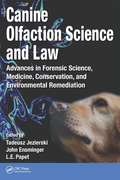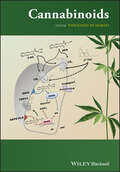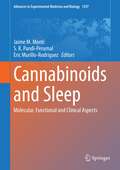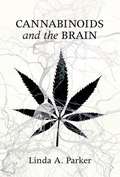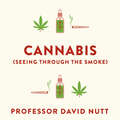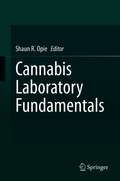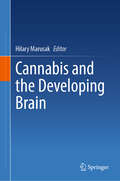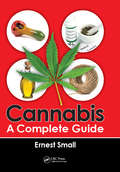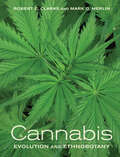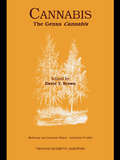- Table View
- List View
Canine Olfaction Science and Law: Advances in Forensic Science, Medicine, Conservation, and Environmental Remediation
by Tadeusz Jezierski John Ensminger L. E. PapetThe value of the canine nose is well-documented, and working dogs are being utilized for their olfactory skills in an increasing number of fields. Not only are dogs used by police, security, and the military, but they are also now used in forensic science, in medical detection of disease, in calculating population trends of endangered species and e
Canine and Feline Anesthesia and Co-Existing Disease
by Lindsey B.C. Snyder Rebecca A. JohnsonCanine and Feline Anesthesia and Co-Existing Disease is the first book to draw together clinically relevant information on the anesthetic management of dogs and cats with existing disease conditions. Providing a detailed reference on avoiding and managing complications resulting from concurrent disease, the book offers a ready reference for handling anesthesia in patients with common presenting diseases. Organized by body system, Canine and Feline Anesthesia and Co-Existing Disease is designed to allow the reader to quickly find and apply advice for anesthetizing patients with specific conditions. Each chapter presents in-depth, practical information on the special considerations before, during, and after sedation and anesthesia of a patient with a given disease. Canine and Feline Anesthesia and Co-Existing Disease is a useful reference for general practitioners, veterinary students, specialists in a variety of areas, and veterinary anesthesiologists alike.
Canine and Feline Skin Cytology
by Francesco AlbaneseThe second edition of Canine and Feline Skin Cytology is the most comprehensive work on the subject. The book provides veterinary students and veterinarians with a diagnostic tool that is now essential in the interpretation of skin lesions; in addition, the very rich iconography, including numerous histological images, becomes a very useful tool also for pathologists. With more than 1500 clinical, histopathological and cytological images and detailed text, it illustrates both inflammatory and neoplastic skin diseases, with a 360° view. The new book contains 9 chapters, 4 more than the first edition, enriching the manuscript with chapters on new topics such as "backgrounds" and "cell' cytoarchitectures", but above all including numerous skin tumors that were not present in the first edition. The first part of the book describes in detail the morphology of the cells that make up the skin and those that reach the skin tissue during inflammatory processes. The general part also describes the methods of sampling, preparation and staining of slides in order to obtain good quality preparations that are as representative as possible of the lesion to be studied. The "special" chapters on inflammatory and neoplastic diseases and related cytological pictures are the most important parts of the book and have been enriched with numerous new skin diseases, making the work more complete. The last chapter is dedicated to the cytological aspects observed in the course of skin metastases coming from internal organs or from the mammary gland. This book is an essential diagnostic tool for veterinary students and practitioners alike.
Cann's Principles Of Molecular Virology
by Edward P. RybickiCann's Principles of Molecular Virology, Seventh Edition provides an easily accessible introduction to modern virology, presenting principles in a clear and concise manner. The new edition provides the history of virology and the fundamentals of the molecular basis of how viruses work. It discusses the interactions which control the structure of virus particles, the ways viruses infect cells, how viruses replicate themselves, and the consequences and pathogenesis of virus infection for host organisms. This fully updated edition also reflects advances made in the field and includes new content on phage therapy, CRISPR as a phage defense / offense system, new ideas about evolution, and giant viruses. With the addition of ancillary resources, Principles of Molecular Virology, Seventh Edition is an essential foundational reference for academics, graduate students, and advance undergraduates in virology, molecular biology, and microbiology as well as researchers entering virology, infectious disease, and immunology research.
Cannabinoids
by Vincenzo Di MarzoThe 21st century will witness the unprecedented marketing of therapeutic drugs developed from cannabinoids and the endocannabinoid system. Cannabinoids is a timely volume, which represents a comprehensive review of the most important issues in cannabinoid research as well as those of most likely therapeutic relevance. For the first time, the multi-faceted aspects of cannabinoid chemistry, biology and medicine are presented in one volume. Key topics of discussion: -major families of phytocannabinoids; -pharmacological activity of phytocannabinoids; -interactions of phytocannabinoids with their proposed molecular target; -components of the endocannabinoid system; -molecular mechanisms of the endocannabinoid system; -Physiological and pathological role of endocannabinoids; -industrial applications of studies on the cannabinoids; -therapeutic uses of agonists and antagonists of cannabinoids receptors. This book is a must for graduate and pre- and post-doctoral students in disciplines ranging from organic and natural product chemistry, pharmacology, biochemistry and medicine.
Cannabinoids and Neuropsychiatric Disorders (Advances in Experimental Medicine and Biology #1264)
by Jaime M. Monti S. R. Pandi-Perumal Eric Murillo-RodriguezThis volume highlights the recent advances in the understanding of the endocannabinoid system and the likely benefit from the therapeutic effects of cannabinoid treatment in a variety of health issues.Archeological evidence has shown that Cannabis has a long history of use for multiple purposes, including the treatment of medical conditions. The primary active constituent of the hemp plant Cannabis sativa, delta 9-tetrahydrocannabinol (Δ9-THC), causes euphoria, enhancement of sensory perception, tachycardia, antinociception, difficulties in concentration and impairment of memory, among other effects. Despite these undesirable effects, signaling is mostly inhibitory and suggests a putative role for cannabinoids as therapeutic agents by managing several diseases where inhibition of neurotransmitter release would be beneficial. The themes of this book have been edited and written by world-leaders in the field, The contents of the volume aims at readers from a range of academic and professional disciplines, such as biomedicine, several areas of biology, neurology, clinical medicine and pharmacy.
Cannabinoids and Sleep: Molecular, Functional and Clinical Aspects (Advances in Experimental Medicine and Biology #1297)
by Jaime M. Monti S. R. Pandi-Perumal Eric Murillo-RodríguezResearch on cannabis and sleep is emerging with promising results. This book offers current and comprehensive knowledge on cannabinoid research results in connection with sleep. The volume covers aspects of the hemp plant Cannabis sativa, the pharmacology of cannabinoids, neurobiology and pharmacology of sleep and wakefulness, and the benefits and side effects of cannabis on the central nervous system. It further discusses the putative therapeutical properties of cannabinoids and endocannabinoids and their potential for the treatment of sleep disorders such as insomnia, obstructive sleep apnea, REM sleep behavior disorder, and restless legs syndrome. The book is written by medical and scientific experts in this field and intended for researchers from a range of disciplines such as biomedicine, biology, neurosciences, clinical medicine, neurology, and pharmacology.
Cannabinoids and the Brain
by Linda A. ParkerThe cannabis plant has been used for recreational and medicinal purposes for more than 4,000 years, but the scientific investigation into its effects has only recently yielded useful results. In this book, Linda Parker offers a review of the scientific evidence on the effects of cannabinoids on brain and behavioral functioning, with an emphasis on potential therapeutic uses. Parker describes the discovery of tetrahydocannbinol (THC), the main psychoactive component of cannabis, and the further discovery of cannabinoid receptors in the brain. She explains that the brain produces chemicals similar to THC, which act on the same receptors as THC, and shows that the endocannabinoid system is involved in all aspects of brain functioning. Parker reports that cannabis contains not only the psychoactive compound THC, but also other compounds of potential therapeutic benefit, and that one of them, cannabidiol (CBD), shows promise for the treatment of pain, anxiety, and epilepsy. Parker reviews the evidence on cannabinoids and anxiety, depression, mood, sleep, schizophrenia, learning and memory, addiction, sex, appetite and obesity, chemotherapy-induced nausea, epilepsy, and such neurodegenerative disorders as multiple sclerosis and Alzheimer's Disease. Each chapter also links the scientific evidence to historical and anecdotal reports of the medicinal use of cannabis. As debate about the medical use of marijuana continues, Parker's balanced and objective review of the fundamental science and potential therapeutic effects of cannabis is especially timely.
Cannabinoids and the Brain (The\mit Press Ser.)
by Linda A. ParkerA review of the scientific evidence on the effects of cannabinoids on brain and behavioral functioning, with an emphasis on potential therapeutic use.The cannabis plant has been used for recreational and medicinal purposes for more than 4,000 years, but the scientific investigation into its effects has only recently yielded useful results. In this book, Linda Parker offers a review of the scientific evidence on the effects of cannabinoids on brain and behavioral functioning, with an emphasis on potential therapeutic uses.Parker describes the discovery of tetrahydocannbinol (THC), the main psychoactive component of cannabis, and the further discovery of cannabinoid receptors in the brain. She explains that the brain produces chemicals similar to THC, which act on the same receptors as THC, and shows that the endocannabinoid system is involved in all aspects of brain functioning. Parker reports that cannabis contains not only the psychoactive compound THC, but also other compounds of potential therapeutic benefit, and that one of them, cannabidiol (CBD), shows promise for the treatment of pain, anxiety, and epilepsy. Parker reviews the evidence on cannabinoids and anxiety, depression, mood, sleep, schizophrenia, learning and memory, addiction, sex, appetite and obesity, chemotherapy-induced nausea, epilepsy, and such neurodegenerative disorders as multiple sclerosis and Alzheimer's Disease. Each chapter also links the scientific evidence to historical and anecdotal reports of the medicinal use of cannabis.As debate about the medical use of marijuana continues, Parker's balanced and objective review of the fundamental science and potential therapeutic effects of cannabis is especially timely.
Cannabis (seeing through the smoke): The New Science of Cannabis and Your Health
by Professor David NuttThe definitive guide to Cannabis and your health, from world-renowned Professor of Neuropsychopharmacology, David Nutt.Underpinned by his two-year research trial in partnership with the Royal College of Psychiatrists, involving up to 20,000 patients, which will create Europe's largest body of evidence on the plant's medicinal qualities - Professor David Nutt and his team of scientists will break the mould on the way we use Cannabis for our health in the future. In David's first ground-breaking book on the subject, he will cover its impact of all areas of the body and the brain and its effective use for treatment of illness from chronic pain, epilepsy, multiple sclerosis and PTSD, to anxiety and depression. This is the essential knowledge that cuts through the noise and give us evidence-based information that will change people's lives.(P)2021 Hodder & Stoughton Limited
Cannabis (seeing through the smoke): The New Science of Cannabis and Your Health
by Professor David NuttTHE DEFINITIVE GUIDE TO CANNABIS AND YOUR HEALTHUnderpinned by his two-year research trial in partnership with the Royal College of Psychiatrists, involving up to 20,000 patients, which will create Europe's largest body of evidence on the plant's medicinal qualities - Professor David Nutt and his team of scientists will break the mould on the way we use Cannabis for our health in the future. In David's first ground-breaking book on the subject, he will cover its impact of all areas of the body and the brain and its effective use for treatment of illness from chronic pain, epilepsy, multiple sclerosis and PTSD, to anxiety and depression. This is the essential knowledge that cuts through the noise and give us evidence-based information that will change people's lives.
Cannabis (seeing through the smoke): The New Science of Cannabis and Your Health
by Professor David NuttTHE DEFINITIVE GUIDE TO CANNABIS AND YOUR HEALTHUnderpinned by his two-year research trial in partnership with the Royal College of Psychiatrists, involving up to 20,000 patients, which will create Europe's largest body of evidence on the plant's medicinal qualities - Professor David Nutt and his team of scientists will break the mould on the way we use Cannabis for our health in the future.In David's first ground-breaking book on the subject, he will cover its impact of all areas of the body and the brain and its effective use for treatment of illness from chronic pain, epilepsy, multiple sclerosis and PTSD, to anxiety and depression. This is the essential knowledge that cuts through the noise and give us evidence-based information that will change people's lives.
Cannabis Laboratory Fundamentals
by Shaun R. OpieThe legislative requirement for cannabis to undergo laboratory testing has followed legalization of medical and recreational use in every U.S. state to date. Cannabis safety testing is a new investment opportunity within the emerging cannabis market that is separate from cultivation, processing, and distribution, allowing individuals and organizations who may have been reluctant to enter previously a new entry route to the cannabis space. However, many of the costs, timelines, operational requirements, and compliance issues are overlooked by people who have not been exposed to regulated laboratory testing. Cannabis Laboratory Fundamentals provides an in-depth review of the key issues that impact cannabis testing laboratories and provides recommendations and solutions to avoid common – but expensive – mistakes. The text goes beyond methodology to include sections on economics, regulation, and operational challenges, making it useful for both new and experienced cannabis laboratory operators, as well as all those who want to understand the opportunities and risks of this industry.
Cannabis Physiopathology Epidemiology Detection: Physiopathology, Epidemiology, Detection: From The Proceedings Of The Second International Symposium, Organized By The National Academy Of Medicine, With The Assistance Of The City Of Paris, April 8-9 1992 (CRC Press Revivals)
by Gabriel G. NahasCannabis Physiopathology and Detection features an outstanding collection of contributions from leading researchers around the world. Papers were presented at the Second International Colloquium on Illicit Drugs, held at the French National Academy of Medicine in April 1992. The book reviews the latest clinical reports describing the effects of cannabis on the brain (imaging techniques, memory and psychomotor performance, cannabis, and schizophrenia), effects on reproduction (male and female), and carcinogenicity. Aspects of detection covered in the volume include methods, results of different testing groups, and legal issues associated with testing and detection.Cannabis Physiopathology and Detection will be an important addition to the reference collections of marijuana researchers, pathologists, government agencies, medical school libraries, and drug testers.
Cannabis Therapy in Veterinary Medicine: A Complete Guide
by James S. Gaynor Stephen Cital Katherine Kramer Liz HughstonThis book provides in-depth information on the applications of cannabis products as a legitimate medicine in treating a variety of diseases and disorders in domestic animals. Pharmacology and toxicology of cannabinoids and their effects on the endocannabinoid system, which is involved in the regulation of diverse physiological and cognitive processes, are discussed in detail. Furthermore, the book reviews development and testing of cannabis based medical products and introduces the nutritional components of cannabis plants. Cannabis as a therapeutic in veterinary medicine is gaining interest among owners and practitioners. Numerous studies have been completed or are currently underway that analyze the potential of clinical application of cannabinoid and terpenoid molecules. In this book the authors take a comprehensive look at previous studies in animal and human models and discuss translational applications based on these scientific data. This seminal text serves as a go-to resource for veterinary practitioners on cannabinoid therapy. It will also serve as a foundation for clinicians and researchers interested in this emerging field of veterinary medicine.
Cannabis and the Developing Brain
by Hilary MarusakThis book draws on the latest scientific research to explore the potential impact of cannabis use on the developing brain. The authors first describe the endocannabinoid system and its role in shaping neurodevelopment and cognitive and emotion-related functioning throughout the lifespan. Then they discuss the effects of cannabis and cannabinoids on cognitive function, mental health, and brain structure and function during pregnancy, childhood, and adolescence. With a balanced and evidence-based approach, Cannabis and the Developing Brain provides comprehensive coverage of the emerging science in this area, helping researchers, policy makers, educators and parents who seek to navigate the complex landscape of cannabis use in youth and pregnant people.
Cannabis/Hemp for Sustainable Agriculture and Materials
by Dinesh Chandra Agrawal Rajiv Kumar Muralikrishnan DhanasekaranThe book contains review articles on the latest evidence-based scientific knowledge and future insights on industrial hemp applications ranging from sustainable agriculture, sustainable development, and commercial uses of hemp-derived innovative products. The research articles evaluate and review the latest research and development on hemp’s agronomy, ecophysiology, the opportunities and challenges of hemp cultivation in the different regions of the world, including Africa.The book reviews complete patent literature on hemp from the publication of the first patent in 1856 till the end of 2020, providing an excellent insight into hemp’s business growth and future potential for industrial applications along with region- and sector-wise patenting activity concerning industrial hemp. In addition, articles describe the applications of hemp-derived green materials for building construction, wastewater treatment, and water purification. The book will be useful as a reference book for students, researchers, farmers, business houses, and individuals interested in industrial hemp for commercial aspects, sustainable development, farming, and other hemp-derived innovative products.
Cannabis: A Complete Guide
by Ernest SmallCannabis sativa is best known as the source of marijuana, the world’s most widely consumed illicit recreational drug. However, the plant is also extremely useful as a source of stem fiber, edible seed oil, and medicinal compounds, all of which are undergoing extremely promising research, technological applications, and business investment. Indeed, despite its capacity for harm as a recreational drug, cannabis has phenomenal potential for providing new products to benefit society and for generating extensive employment and huge profits. Misguided policies, until recently, have prevented legitimate research on the beneficial properties of cannabis, but there is now an explosion of societal, scientific, and political support to reappraise and remove some of the barriers to usage. Unfortunately, there is also a corresponding dearth of objective analysis. Towards redressing the limitation of information, Cannabis: A Complete Guide is a comprehensive reference summarizing botanical, business, chemical, ecological, genetic, historical, horticultural, legal, and medical considerations that are critical for the wise advancement and management of cannabis in its various forms. This book documents both the risks and benefits of what is indisputably one of the world’s most important species. The conflicting claims for medicinal virtues and toxicological vices are examined, based mainly on the most recent authoritative scientific reviews. The attempt is made consistently to reflect majority scientific opinion, although many aspects of cannabis are controversial. Aside from the relevance to specialists, the general public should find the presentation attractive because of the huge interest today in marijuana. Unfortunately, society has become so specialized and compartmentalized that most people have limited appreciation of the importance of science to their lives, except when a topic like marijuana becomes sensationalized. This review of cannabis can serve as a vehicle for public education in the realm of science and technology. Indeed, towards the goal of disseminating the important information in this book to a wide audience, the presentation is user-friendly, concise, and well-illustrated in the hope that non-specialists will find the topics both informative and entertaining.
Cannabis: Evolution and Ethnobotany
by Mark Merlin Robert ClarkeCannabis: Evolution and Ethnobotany is a comprehensive, interdisciplinary exploration of the natural origins and early evolution of this famous plant, highlighting its historic role in the development of human societies. Cannabis has long been prized for the strong and durable fiber in its stalks, its edible and oil-rich seeds, and the psychoactive and medicinal compounds produced by its female flowers. The culturally valuable and often irreplaceable goods derived from cannabis deeply influenced the commercial, medical, ritual, and religious practices of cultures throughout the ages, and human desire for these commodities directed the evolution of the plant toward its contemporary varieties. As interest in cannabis grows and public debate over its many uses rises, this book will help us understand why humanity continues to rely on this plant and adapts it to suit our needs.
Cannabis: From Pariah to Prescription
by Ethan B RussoLearn more about tomorrow&’s alternative to today&’s risk-laden prescription drugs! Cannabis: From Pariah to Prescription reviews the latest research from recent clinical trials with cannabis and cannabinoids-outlining their place and future as prescription medicines. This book addresses the "road back" for cannabis medicines and society&’s reacceptance of cannabis as a prescription product. This book offers physicians, patients, scientists, and students a primer on this developing branch of pharmacology and therapeutics and is ideal for use in courses for medicine, psychopharmacology, alternative medicine, health policy, and pharmacology. Cannabis: From Pariah to Prescription assesses the genetics, horticulture, and biochemical processing of cannabis into cannabis-based medicine extracts (CBMEs). The book describes the important advanced technologies used to cultivate the genetically selected medical-grade cannabis cloned strains in glass houses. This book also discusses new advancements in drug delivery alternatives to traditional smoking, including the Advanced Delivery System (ADS)-a device that allows delivery of premeasured dosages while remaining secure, tamper-proof, and patient specific. In Cannabis: From Pariah to Prescription, the practical applications of cannabis pharmaceuticals are explored through a wide range of clinical studies, including: a thorough discussion of the latest in documented benefits and side effects when using cannabis, cannabinoids, or CBMEs a tolerability study via multiple administration routes to compare pharmacodynamic effects and pharmacokinetic characteristics a comparative study of the pharmacokinetic profiles administered in various areas of the buccal mucosa as well as an investigation of the pharmacokinetics of CBME administered orally a blind study assessing pharmacokinetic profile of CBME administered sublingually in various ratios of cannabinoids a review of several other recent trials involving CBME, THC, or cannabis a study reviewing the human clinical experience to date employing synthetic cannabinoids or CBME, suggesting future treatment in the areas of obstetrics, gynecology, and pediatrics Cannabis: From Pariah to Prescription provides extensive bibliographies to encourage your examination of previous studies and international literature. Europe remains on the cutting edge of new studies and research on cannabinoids, and much of the data in this book was collected in the United Kingdom. This meticulous resource also contains a list of abbreviations and definitions of terms from GW Pharmaceuticals to make the reading more accessible to a wide variety of readers.
Cannabis: The Genus Cannabis (Medicinal And Aromatic Plants - Industrial Profiles Ser. #Vol. 4)
by David T. BrownThis book provides a comprehensive overview of cannabis use and abuse and will be an invaluable source of reference for anyone with an interest in the wide range of applications of this fascinating plant and its therapeutic and commercial potential
Cannibalism: A Perfectly Natural History (Wellcome Ser.)
by Bill Schutt“Surprising. Impressive. Cannibalism restores my faith in humanity.” —Sy Montgomery, The New York Times Book Review For centuries scientists have written off cannibalism as a bizarre phenomenon with little biological significance. Its presence in nature was dismissed as a desperate response to starvation or other life-threatening circumstances, and few spent time studying it. A taboo subject in our culture, the behavior was portrayed mostly through horror movies or tabloids sensationalizing the crimes of real-life flesh-eaters. But the true nature of cannibalism--the role it plays in evolution as well as human history--is even more intriguing (and more normal) than the misconceptions we’ve come to accept as fact. In Cannibalism: A Perfectly Natural History,zoologist Bill Schutt sets the record straight, debunking common myths and investigating our new understanding of cannibalism’s role in biology, anthropology, and history in the most fascinating account yet written on this complex topic. Schutt takes readers from Arizona’s Chiricahua Mountains, where he wades through ponds full of tadpoles devouring their siblings, to the Sierra Nevadas, where he joins researchers who are shedding new light on what happened to the Donner Party--the most infamous episode of cannibalism in American history. He even meets with an expert on the preparation and consumption of human placenta (and, yes, it goes well with Chianti). Bringing together the latest cutting-edge science, Schutt answers questions such as why some amphibians consume their mother’s skin; why certain insects bite the heads off their partners after sex; why, up until the end of the twentieth century, Europeans regularly ate human body parts as medical curatives; and how cannibalism might be linked to the extinction of the Neanderthals. He takes us into the future as well, investigating whether, as climate change causes famine, disease, and overcrowding, we may see more outbreaks of cannibalism in many more species--including our own.Cannibalism places a perfectly natural occurrence into a vital new context and invites us to explore why it both enthralls and repels us.
Canon Controversies in Political Thought: Two Theories of Influence
by Dominic WelburnThis book explores the meaning of 'influence', which has played a central role in the formation of the canon, or tradition, of Western political thought. Via a critical overview of the relative fortunes of influence studies in the history of political thought, literary theory, and – at times – the history of art and poetry, it is possible to identify a dominant theory of the term. Nietzschean and ‘emanational’ in nature, thanks largely to the work of Harold Bloom, this particular theory views influence as mere power and represents a broadly accepted meaning in twentieth century thought. Canons or traditions of thought came to be institutions in themselves reflecting prevalent social and political inequalities. To be sure, a theory of influence as power came to be seen as complicit in arbitrary canon formation, across a range of disciplines. The book argues, ultimately, that a second theory of influence, imported from Mary Orr’s work on intertextuality, affords a rival perspective and a more positive, intergenerational meaning of influence. Orr’s ‘braided rope’ theory of influence allows for the development of a plurality of canons each capable of constructing new histories for a variety of epistemic communities. The existence of agonistic, rival canons presents pedagogical questions for all teachers of political theory, but one that can be potentially navigated by a new understanding of influence, in the Orrian tradition.
Canonical Duality Theory: Unified Methodology for Multidisciplinary Study (Advances in Mechanics and Mathematics #37)
by Ning Ruan David Yang Gao Vittorio LatorreThis book on canonical duality theory provides a comprehensive review of its philosophical origin, physics foundation, and mathematical statements in both finite- and infinite-dimensional spaces. A ground-breaking methodological theory, canonical duality theory can be used for modeling complex systems within a unified framework and for solving a large class of challenging problems in multidisciplinary fields in engineering, mathematics, and the sciences. This volume places a particular emphasis on canonical duality theory's role in bridging the gap between non-convex analysis/mechanics and global optimization. With 18 total chapters written by experts in their fields, this volume provides a nonconventional theory for unified understanding of the fundamental difficulties in large deformation mechanics, bifurcation/chaos in nonlinear science, and the NP-hard problems in global optimization. Additionally, readers will find a unified methodology and powerful algorithms for solving challenging problems in complex systems with real-world applications in non-convex analysis, non-monotone variational inequalities, integer programming, topology optimization, post-buckling of large deformed structures, etc. Researchers and graduate students will find explanation and potential applications in multidisciplinary fields.
Canonical Problems in the Theory of Plasmonics: From 3D to 2D Systems (Springer Series in Optical Sciences #230)
by Afshin MoradiThis book provides a systemic and self-contained guide to the theoretical description of the fundamental properties of plasmonic waves. The field of plasmonics is built on the interaction of electromagnetic radiation and conduction electrons at metallic interfaces or in metallic nanostructures, and so to describe basic plasmonic behavior, boundary-value problems may be formulated and solved using electromagnetic wave theory based on Maxwell’s equations and the electrostatic approximation.In preparation, the book begins with the basics of electromagnetic and electrostatic theories, along with a review of the local and spatial nonlocal plasma model of an electron gas. This is followed by clear and detailed boundary value analysis of both classical three-dimensional and novel two-dimensional plasmonic systems in a range of different geometries. With only general electromagnetic theory as a prerequisite, this resulting volume will be a useful entry point to plasmonic theory for students, as well as a convenient reference work for researchers who want to see how the underlying models can be analysed rigorously.
